The previous post discussed the radicalism that grew in the 20s. Here’s something else altogether:
Calling All Ghosts: Ouija Boards, Spiritualism, and Harry Houdini
One of the central images of SIRENS is that of ghosts and spirits and magic. I found this facet of the 1920s by accident, but it fit so perfectly into the novel I couldn’t ignore it. Cue the spooky music…
Maybe it was the war, maybe it was the influenza outbreak, but people in the 1920s became obsessed with life after death.
There were (well, yeah, there still are) two camps: those who believed in life after, and those who didn’t. Harry Houdini didn’t. Sir Arthur Conan Doyle and Howard Thurston did.
Houdini and Thurston were both magicians, so they knew how to pull the wool over someone’s eyes. Doyle – Mr. Sherlock Holmes – knew how to uncover secrets. These three were all good friends, and they argued this point excessively. Were there spirits? Ghosts? Was there life after death? Who could prove the point?
Two of the popular parlor games of the 1920s were séances and Ouija boards. Both of these purported to channel the dead through a medium, in the case of a séance, or through the group emotions, in the case of a Ouija board (if you’ve never played with the latter, it’s kind of fun. But you have to suspend your disbelief. That makes it spooky.) The dead would send, through these media, obscure messages back to the living.
Magic shows were a public phenomenon of the 1920s, and two of the greatest magicians were Harry Houdini and Howard Thurston. Houdini was a skeptic: he knew how to make people think one thing, but “it was all a trick. Fakery.” Thurston, too, was an excellent magician, but he actually believed that there was something guiding him, a kind of spirit life. The two engaged in a friendly competition, culminating with a wager that the one who died first would haunt the other.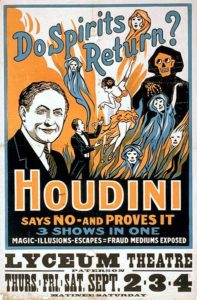
Thurston’s shows were all about spiritualism. He would make a girl float magically in the air; he would make a girl vanish altogether; he would call forth floating apparitions to “speak.” His illusions were some of the best and his popularity high. But Houdini’s renown was greater, due to his amazing performances in escaping dire circumstances. And Houdini’s premature death of peritonitis gave a legendary aspect to his name, since the secrets of his magic act – ironically – went with him to the grave.
Thurston lived on but his magic shows were supplanted by a new public fixation: the moving picture.
As the decade progressed and Americans forgot their heartbreak over the war and their losses during the flu pandemic, and became more and more obsessed with the “new” things – cosmetics, automobiles, wealth, and glamour – preoccupation with spirits slipped away. They didn’t know it, but at the end of the 1920s Americans would bump up against a whole different kind of haunting experience: the Depression.

 treet Bombing of 1920 plays an important role in SIRENS, as the brother of one of the characters died in that blast, and the brothers of two other characters may be implicated in the bombing itself. Since no one knows to this day who carried it out, I was free to play with the possibilities…and the parallels to our own time.
treet Bombing of 1920 plays an important role in SIRENS, as the brother of one of the characters died in that blast, and the brothers of two other characters may be implicated in the bombing itself. Since no one knows to this day who carried it out, I was free to play with the possibilities…and the parallels to our own time.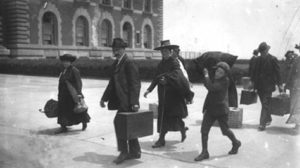 Following World War 1, the number of immigrants coming into the US increased dramatically. Some of those, and some of the returning soldiers, brought ideas about government that were considered hostile to traditional American thinking. “Radicals,” “Bolshevists,” and “anarchists” were a few of terms tossed around, and pretty soon these terms and other derogatory epithets were applied to any foreigner/immigrant whether justified or not (sound familiar?) Tensions ran high, and the “Big Red Scare” created hysteria that set everyone on edge.
Following World War 1, the number of immigrants coming into the US increased dramatically. Some of those, and some of the returning soldiers, brought ideas about government that were considered hostile to traditional American thinking. “Radicals,” “Bolshevists,” and “anarchists” were a few of terms tossed around, and pretty soon these terms and other derogatory epithets were applied to any foreigner/immigrant whether justified or not (sound familiar?) Tensions ran high, and the “Big Red Scare” created hysteria that set everyone on edge. cused. It’s believed that the September 1920 Wall Street bombing was in retaliation for their arrest.
cused. It’s believed that the September 1920 Wall Street bombing was in retaliation for their arrest. es, delivery people and so on out on the streets for lunch break – innocents, all.
es, delivery people and so on out on the streets for lunch break – innocents, all.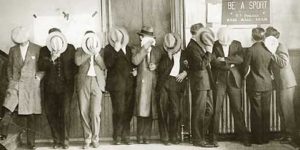 Gangsters really can’t get a foothold unless they can offer something everyone wants but nobody can get legally. In the 1920s, that something was alcohol.
Gangsters really can’t get a foothold unless they can offer something everyone wants but nobody can get legally. In the 1920s, that something was alcohol.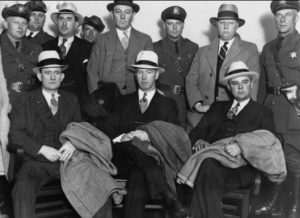 se to the top by his intelligence and by his determination to rise above his poor immigrant upbringing, both fueled by his brutality. Mobsters in general were society’s outcasts, and as the son of immigrant Italians, Capone couldn’t find success in legitimate enterprises. He turned instead to the underworld: gambling, theft, corruption, gun-running, and alcohol.
se to the top by his intelligence and by his determination to rise above his poor immigrant upbringing, both fueled by his brutality. Mobsters in general were society’s outcasts, and as the son of immigrant Italians, Capone couldn’t find success in legitimate enterprises. He turned instead to the underworld: gambling, theft, corruption, gun-running, and alcohol. course – were swanky, happening places. Dancing, smoking, and drinking were extolled in the society columns of writers like “Lipstick”. A girl who couldn’t find a glamorous job, like that of a secretary? She could earn an ok wage as a factory girl, sewing machine operator or domestic servant, but how could she afford to buy the clothes she needed for work and the clothes she wanted for play, plus all the other extras?
course – were swanky, happening places. Dancing, smoking, and drinking were extolled in the society columns of writers like “Lipstick”. A girl who couldn’t find a glamorous job, like that of a secretary? She could earn an ok wage as a factory girl, sewing machine operator or domestic servant, but how could she afford to buy the clothes she needed for work and the clothes she wanted for play, plus all the other extras? of the other myriad activities he’d engaged in, but, ironically, for evading taxes on his illegal profits. It was all the violence around him that really brought him down, culminating in the Saint Valentine’s Day Massacre of 1929, when the public finally turned against him and the cops could no longer look the other way. (Although it must be said that no one was ever brought to trial for that crime, including Big Al.)
of the other myriad activities he’d engaged in, but, ironically, for evading taxes on his illegal profits. It was all the violence around him that really brought him down, culminating in the Saint Valentine’s Day Massacre of 1929, when the public finally turned against him and the cops could no longer look the other way. (Although it must be said that no one was ever brought to trial for that crime, including Big Al.)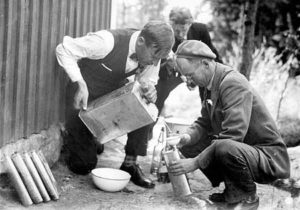
 Al Capone and other gangsters became efficient at transporting alcohol, which resulted in turf wars and deadly raids. Home distillers brewed up alcohol – dubbed “moonshine” – from almost anything, including toxic substances. And “speakeasies” – so called because you were encouraged to speak softly – sprang up all over the country.
Al Capone and other gangsters became efficient at transporting alcohol, which resulted in turf wars and deadly raids. Home distillers brewed up alcohol – dubbed “moonshine” – from almost anything, including toxic substances. And “speakeasies” – so called because you were encouraged to speak softly – sprang up all over the country.
 her undercover job because she was the quintessential flapper: tall and thin, bob-haired, attractive, and dressed for the job.
her undercover job because she was the quintessential flapper: tall and thin, bob-haired, attractive, and dressed for the job.
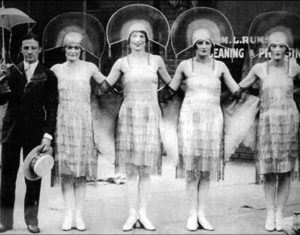
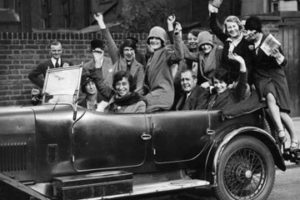 n to traffic in or “bootleg” alcohol. Prohibition also led to the use of “speakeasies” – underground pubs (often literally underground, in basements) where one could buy a drink. Police officers corrupted by easy money looked the other way when alcohol was involved, and backyard distillers made their own “moonshine.”
n to traffic in or “bootleg” alcohol. Prohibition also led to the use of “speakeasies” – underground pubs (often literally underground, in basements) where one could buy a drink. Police officers corrupted by easy money looked the other way when alcohol was involved, and backyard distillers made their own “moonshine.”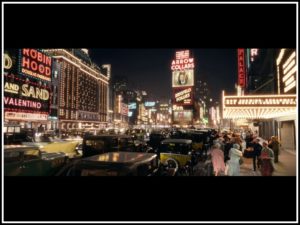
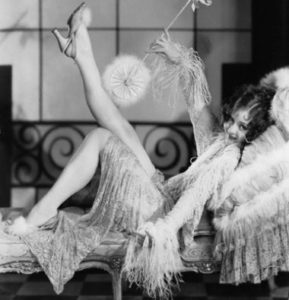 Many other things contributed directly or indirectly to the party-on atmosphere of New York in the 1920s: jazz music, rampant political corruption, increase in the divorce rate, the rise of advertising, the development of cosmetics. Even The Great War and the flu pandemic of 1919 had an impact on this devil-may-care behavior. Regardless of cause, the effect was one of abandoned fun.
Many other things contributed directly or indirectly to the party-on atmosphere of New York in the 1920s: jazz music, rampant political corruption, increase in the divorce rate, the rise of advertising, the development of cosmetics. Even The Great War and the flu pandemic of 1919 had an impact on this devil-may-care behavior. Regardless of cause, the effect was one of abandoned fun. defined in part by how they looked. When in SIRENS Jo meets her cousin Melody, she sees the perfect flapper; and when Jo borrows her cousin’s clothes she worries she’s turning into a flapper. But, golly, it was a great look! And it sure beat wearing those horrific corsets.
defined in part by how they looked. When in SIRENS Jo meets her cousin Melody, she sees the perfect flapper; and when Jo borrows her cousin’s clothes she worries she’s turning into a flapper. But, golly, it was a great look! And it sure beat wearing those horrific corsets.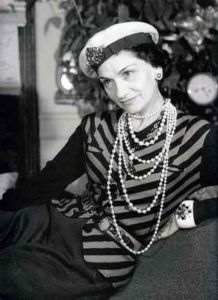

 d with practicality: a factory could produce many more dresses using far less fabric with the new styles. And a girl could walk into a shop with her week’s wages and walk out with the latest flapper style, and have money left over for entertainment.
d with practicality: a factory could produce many more dresses using far less fabric with the new styles. And a girl could walk into a shop with her week’s wages and walk out with the latest flapper style, and have money left over for entertainment. Wait…you didn’t know that once upon a time not so long ago, women in America couldn’t vote?
Wait…you didn’t know that once upon a time not so long ago, women in America couldn’t vote? f women – encouraged women to settle by granting them the right to vote at the state level. But the right of all citizens to vote in any election in America without regard to gender was not granted until the passage of the 19th amendment.
f women – encouraged women to settle by granting them the right to vote at the state level. But the right of all citizens to vote in any election in America without regard to gender was not granted until the passage of the 19th amendment. nt Woodrow Wilson announced that The Great War was a war for democracy, women took this as encouragement and began an even more active campaign for the vote, by picketing the White House and protesting in Washington for equal rights. Women had been involved in the suffrage movement for most of the early twentieth century, but the war catapulted the suffrage movement forward to success.
nt Woodrow Wilson announced that The Great War was a war for democracy, women took this as encouragement and began an even more active campaign for the vote, by picketing the White House and protesting in Washington for equal rights. Women had been involved in the suffrage movement for most of the early twentieth century, but the war catapulted the suffrage movement forward to success. e corset faded (thank goodness) into history.
e corset faded (thank goodness) into history.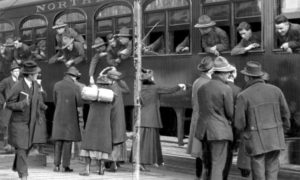
 ng in the war was unanticipated. Men in the 1900s were expected to be “masculine” and repress their emotions. Crying and breaking down were behaviors thought unacceptable, and were often cited as reasons for placement in insane asylums. Doctors, and the public, had no way to understand the experiences of these soldiers, and they were treated indifferently at best and punished for their behavior at worst.
ng in the war was unanticipated. Men in the 1900s were expected to be “masculine” and repress their emotions. Crying and breaking down were behaviors thought unacceptable, and were often cited as reasons for placement in insane asylums. Doctors, and the public, had no way to understand the experiences of these soldiers, and they were treated indifferently at best and punished for their behavior at worst.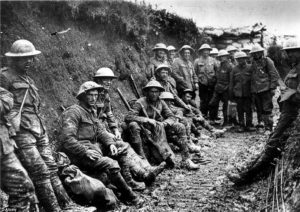 at had been the hope. Technological advancements, urbanization, and immigration led directly to the social upheavals of the 1920s. With so many men serving, killed in action, or returning disabled in body and mind, women had been needed in the work force, and they were reluctant to return to domestic situations, which served to strengthen the cause of women’s suffrage and independence. This independence was evidenced by the adoption of less restrictive clothing and shorter skirts and the fad for shorter hair that was easier to manage.
at had been the hope. Technological advancements, urbanization, and immigration led directly to the social upheavals of the 1920s. With so many men serving, killed in action, or returning disabled in body and mind, women had been needed in the work force, and they were reluctant to return to domestic situations, which served to strengthen the cause of women’s suffrage and independence. This independence was evidenced by the adoption of less restrictive clothing and shorter skirts and the fad for shorter hair that was easier to manage.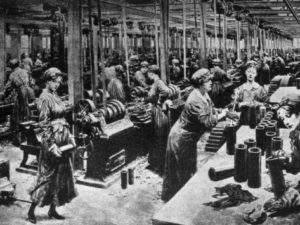 at lives it and the decade that follows it, but the changes in society following World War 1 were rapid and extreme. It would have been a tough homecoming for those soldiers.
at lives it and the decade that follows it, but the changes in society following World War 1 were rapid and extreme. It would have been a tough homecoming for those soldiers.
